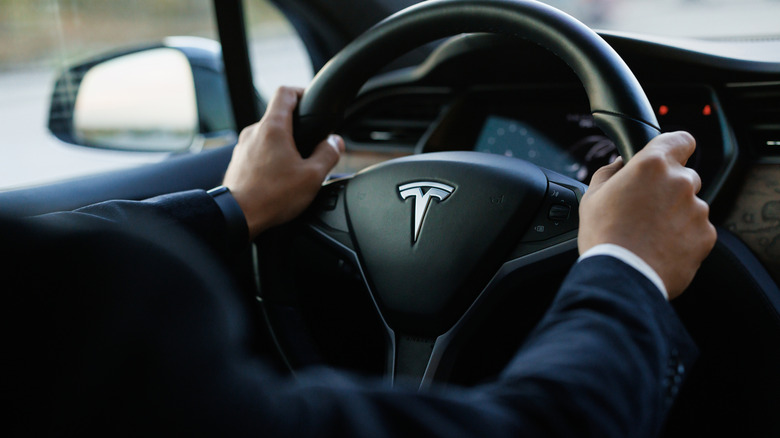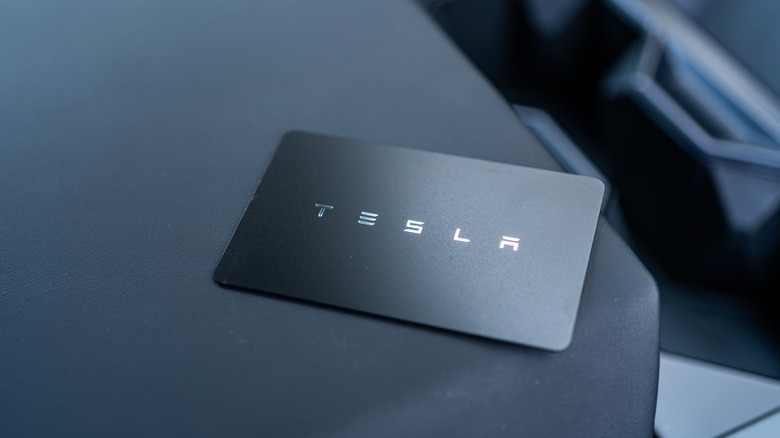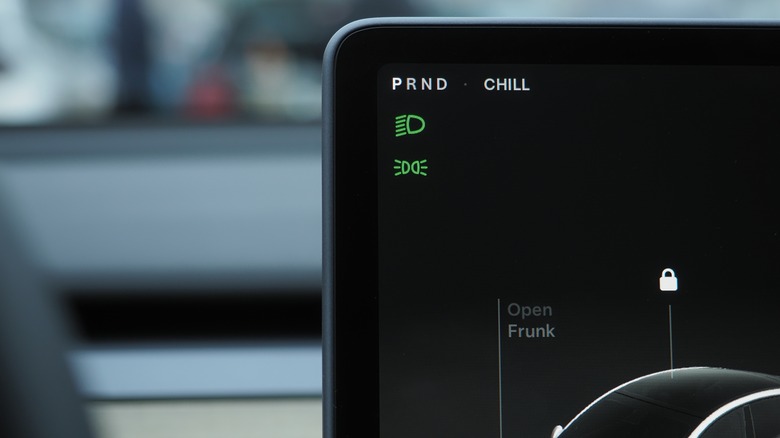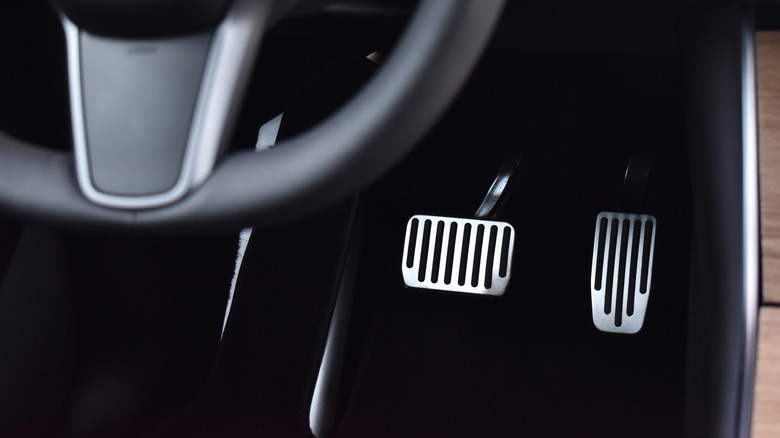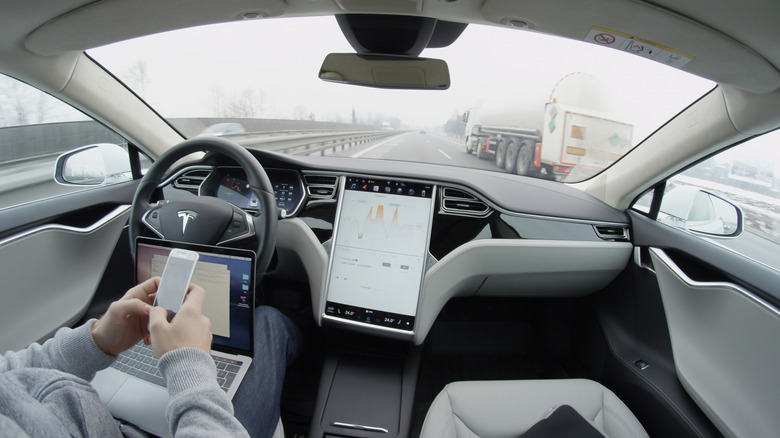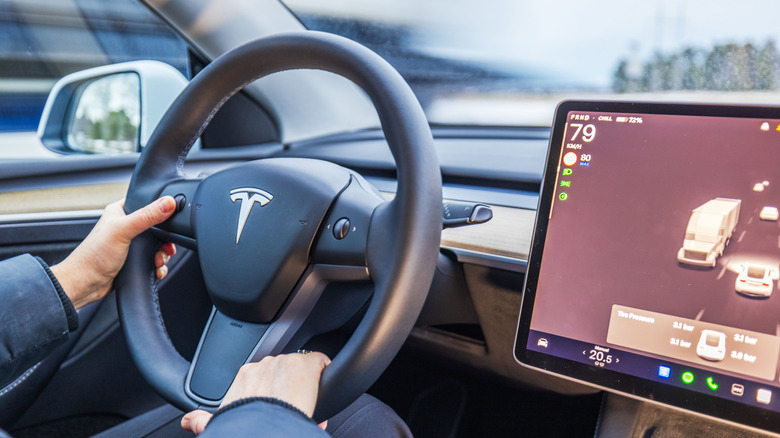5 Things You Need To Know Before Driving A Tesla For The First Time
Even as Elon Musk continues to find ways to ruin his reputation and BYD swiftly overtakes the electric car market under him, Tesla endures. And Tesla EVs don't just remain, they stand out from the crowd. We don't mean stand out like the Cybertruck with its falling resale value in 2025, but rather for its Autopilot features, Supercharger network, and overall smartness, which make them feel like truly futuristic vehicles. We've already discussed 10 things you should know before buying a Tesla, and covered everything you need to know about Tesla insurance. Let's assume you're about to get behind the wheel of your own, or a friend's. There are a handful of things you should keep in mind.
We could spend hours discussing all the quirks and idiosyncrasies of driving one (and those would be many hours), so consider this a crash course — something for someone who's never set foot in a Tesla before and who wants to know the sorts of things that might appear in a quick-start manual. Some of the items here will depend on which model (and which year of that model) you have. The following five are really going to come in handy when you first take a Tesla for a spin.
Use the key card right
Driving a Tesla requires no keys, or at least not the keys we're traditionally used to. The most convenient "key" supported on most models is your phone. The car can unlock automatically when a paired phone gets within Bluetooth range and then lock itself when you walk away. As a fallback option, you have a key card too. Perfect if your phone isn't available or you need to lend it to someone. The key card can unlock, lock, and start a Tesla. Tesla instructs you to press the card on the door pillar next to the driver's side and hop in. Now here's the slightly confusing part: You have two minutes from the moment you tap the card to start the car. Instead of turning a key or pressing a button, you have to hold down on the brake pedal.
You'll have to use the second way to authenticate if you miss that two-minute window. In most Tesla models, including the most recent versions of the Model S, Model X, and Model 3, the key card must be set down in a phone dock slot. After that, you're ready to hit that brake pedal and start driving. Older models sometimes feature unusual key card authentication slots. In the 2017-2023 Tesla Model 3, the RFID transmitter is tucked away under the lip of the console right behind your cup holders.
Take extra care with that RFID key card. One of the unexpected things the Flipper Zero hacking device can do is clone RFID cards — and that's just one example. While the threat of RFID-skimming isn't something that should keep you up at night, a simple Tesla hack easily unlocked cars in the past (and still does), so safeguard it well.
Learn how to shift gears
Changing gears in a Tesla is different from most other cars out there. Same as before, we're referencing the latest versions of the Model S, Model X, and Model 3. The most convenient method of shifting is to use Auto Shift or Auto Shift from Park — both beta features you must manually enable and accept the risk of using. Basically, the car figures out whether you're heading out or going to park and get out, and automatically shifts to drive (or park) accordingly. Tesla warns that you should always check your car is in the right gear before hitting the accelerator.
The second option is to use the touchscreen. Somewhat confusingly, the gear shifter is a slim ribbon on the left side. Drive is enabled by dragging the little car icon up, and reverse by dragging it down. Park and neutral get their own dedicated buttons above and below the shifter. This disappears at high speeds and, in some cases, may require an inward swipe to reveal it. Older models like the 2017-2023 Model 3 use a stalk instead of a touchscreen.
Less confusingly, you can use your center console's buttons: P, R, N, and D, with a hazard light button in the middle. These are on the center console for the Model S and X, but overhead for the Model 3. Don't worry about accidental shifts; Tesla requires the brake pedal to be pressed before the P, R, N, or D buttons work, at which point the LED lights up to confirm. Also, a Tesla intelligently puts the car in park when it detects a user action that poses a risk. For example, unbuckling your seat belt automatically shifts the car into park if it wasn't already.
Go easy on the accelerator
If you've never driven an EV before, then one thing that may catch you off guard is how quickly electrics accelerate. As in, 0-to-60 in 3 seconds with the Tesla Model 3 — that's in performance mode with a lead foot slamming the pedal to the floor, but still. Most consumer ICE vehicles can't even dream of acceleration like that. Such high EV speeds have spawned their own category of YouTube video where unsuspecting passengers get the shock of a lifetime as the driver sends the Tesla screaming (quietly) down an open road at full tilt. Most Tesla models (even those over a decade old) can get close to that three-second sprint. That includes the Tesla Model X, an SUV. Same for the Cyberbeast's top speed, which belies the fact that it's a heavy truck — after all, part of the Cybertruck's promotional material included it outsprinting a Porsche while towing a Porsche. Case in point: Teslas are consumer cars that go stupid fast despite not being intended for the Indy 500.
What's the takeaway here? Even if it's a clear noon day on a country backroad without a soul for miles, be judicious when accelerating. In suburban or urban areas, that goes double. Don't let your impatience to get to work on time send you off the roadside into a ditch or into the back of another car. And in case it wasn't already obvious, don't set the speed demon in you free now that you have all this horsepower. Get a feel for the handling and acceleration, and then maybe take a ride down a highway with a high speed limit. Don't end up like Marques Brownlee going 96 in a school zone.
Autopilot is not Full Self-Driving, and Full Self-Driving is not full self-driving
One of the biggest myths about Tesla self-driving is exactly that: self-driving. Part of the issue is branding. Tesla has two separate functions where the vehicle takes control: Autopilot and Full Self-Driving (colloquially known as FSD). Autopilot sounds like the car doing everything, but it's actually better to call it driver assistance. Similar to other modern driver-assisted vehicles, it can keep to a lane, check your blind spots for hard-to-see cars, or slam on the brakes to prevent a rear-ender. All of this requires you to have your hands on the wheel and maintain full alertness — and intervene when necessary. You may remember the Tesla phantom braking issue that got Elon Musk facing several federal investigations. That was thanks to Autopilot. While autopilot features are undeniably convenient, they're not to be trusted 100%.
Then there's FSD. FSD is in beta (read: not complete), and how good it is depends on whom you ask. YouTuber Snazzy Labs demonstrated how a 2022 Tesla Model 3 handled suburban streets commendably on its own. YouTuber Ben Jordan watched in horror as his self-piloting Tesla ran over a fake mannequin child standing in the road for testing — among other things.
The fact of the matter is that Full Self-Driving is not really full self-driving, and may not be for some time. It has to be supervised, which is why FSD (probably as a result of lawsuits) is now Full Self-Driving (Supervised). So if you climb into a Tesla hoping for it to take you to work and back while you nap, think again. Too many people have already fallen asleep while letting their Teslas drive for them.
Use voice commands
Teslas are cars of the future, so they wouldn't be all that futuristic if they didn't let you control them to some extent with your voice. Luckily, they do. The Model S, Model X, Model 3, and Model Y all support voice commands, though with varying microphone activation methods. The S and X have a voice button on the steering wheel. The 3 and Y have it on both their wheel and touchscreen. Tesla notes that you won't be able to use this to, say, put your car in reverse or increase speed, but you can do almost anything unrelated to physical driving. Super helpful, since it's not safe to be hunting around a touchscreen looking for temperature and volume controls while barreling down the highway, especially if this is your first time. Tesla says that almost anything you can find on the touchscreen can be controlled with voice commands.
Beyond changing the music playlist or asking for directions, you can control windshield wipers, lock the doors, change screen brightness, and a lot more. Tesla also notes that you can use natural language. For example, telling your Tesla that you're feeling cold will automatically be interpreted as a command to up the temperature. Thankfully, this won't be like activating Siri on iPhone, where saying "I'm feeling cold" would cause her to search Google for Benjamin Franklin facts.
Figure out how to activate the microphone ahead of time so that you can easily and safely change things on the go. Keep in mind that this also works with your phone, so some commands (like starting a call or sending a text) will work as well. Since this is an ongoing development, expect accuracy and functionality to improve with time.
